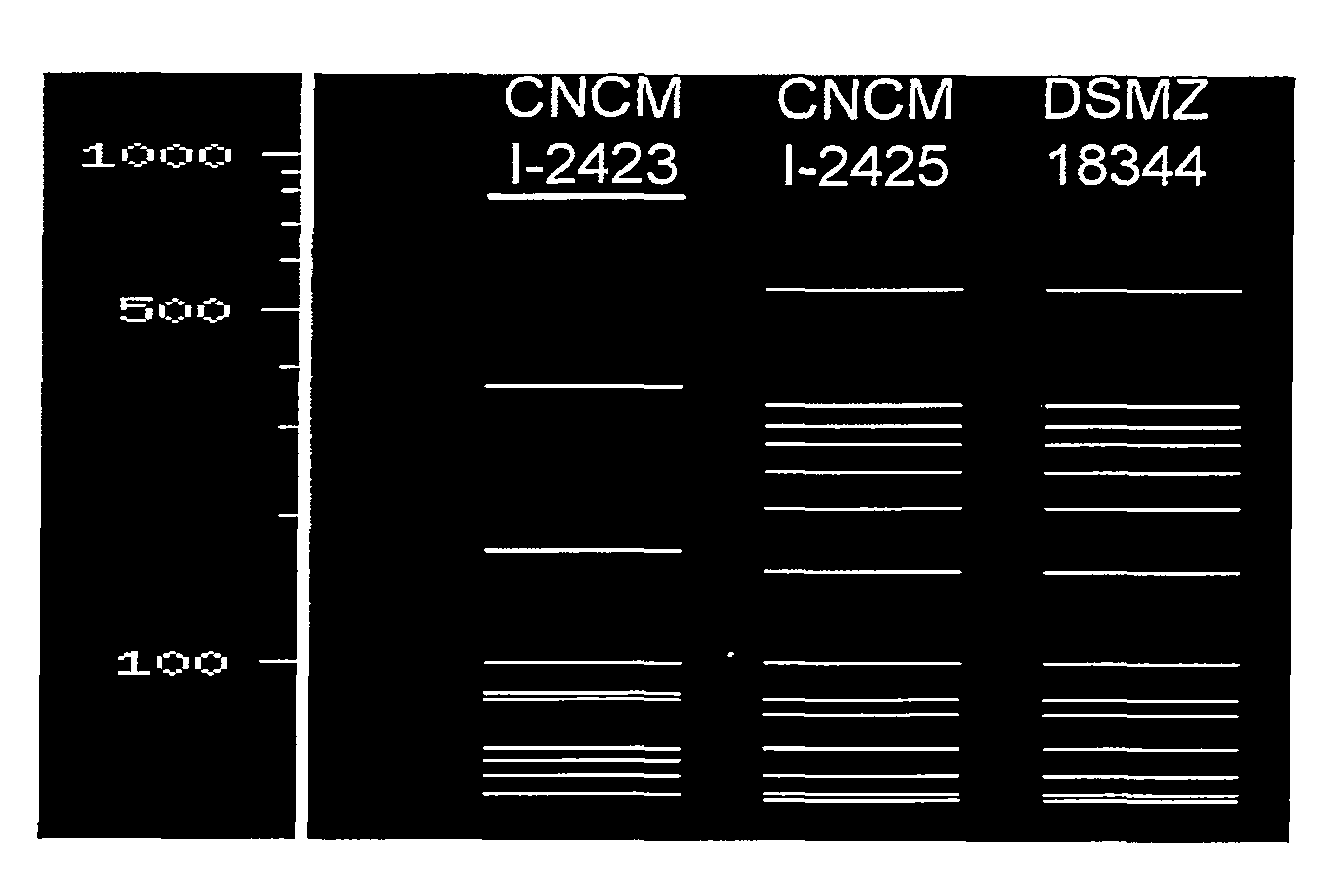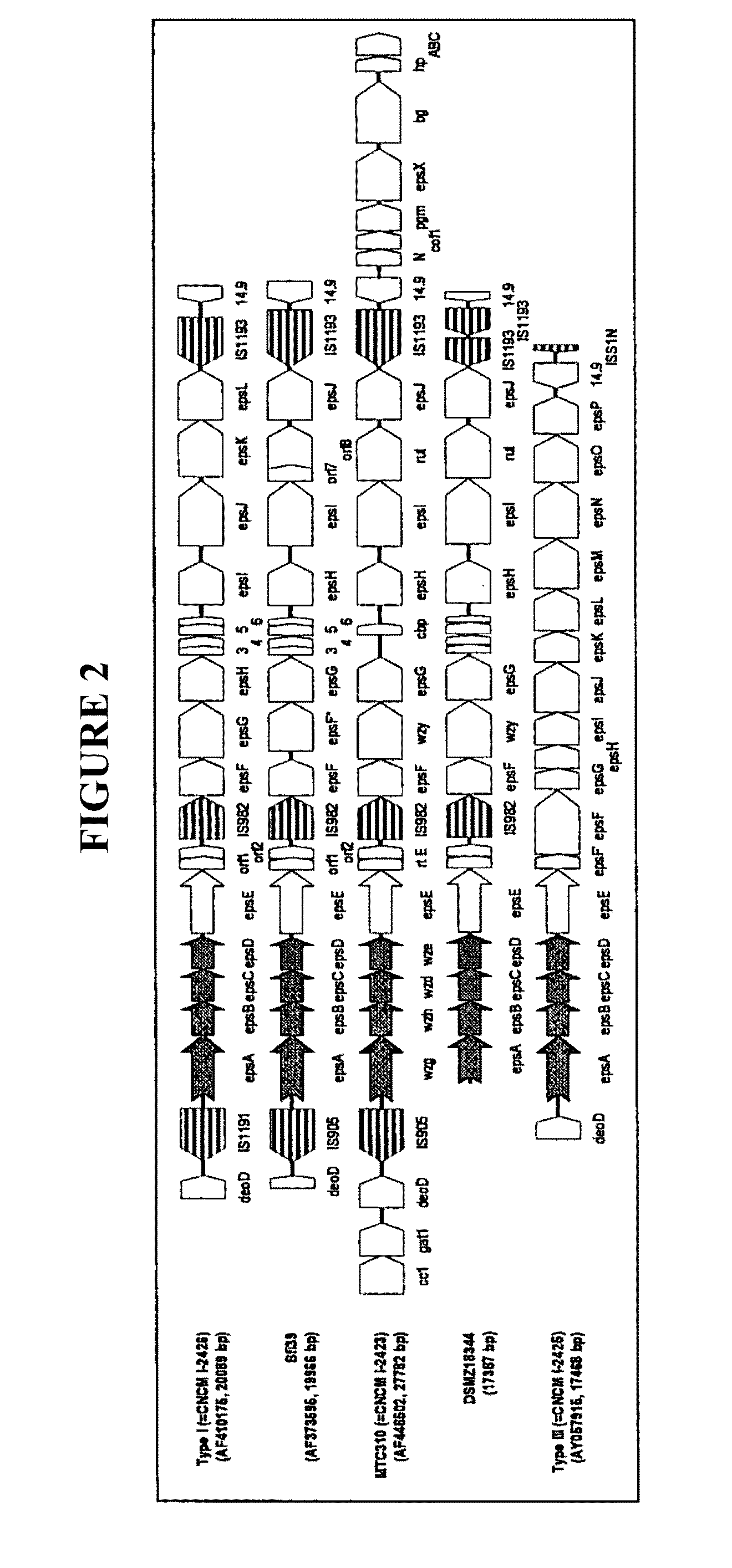Bacterium
a lactic acid bacterium and acidification technology, applied in the field of bacteria, can solve the problems of occupying a large space and equipment, affecting the quality of culture, and a large risk of contamination with spoilage bacteria and/or phages, and achieve the effect of resisting stirring
- Summary
- Abstract
- Description
- Claims
- Application Information
AI Technical Summary
Benefits of technology
Problems solved by technology
Method used
Image
Examples
example 1
Streptococcus thermophilus DSMZ-18344 is a Fast Acidifier of Milk
[0261]The speed of acidification of milk during the fermentation process is −0.0153 upH / min, compared to 0.0129 upH / min, 0.0167 upH / min and 0.0209 upH / min for Streptococcus thermophilus CNCM I-2423, Streptococcus thermophilus CNCM I-2980 and Streptococcus thermophilus CNCM I-2425, respectively.
example 2
Streptococcus thermophilus DSMZ-18344 Generates Fermented Milk with a Superior Viscosity
[0262]Fresh fermented milks are produced at lab scale. The milk base is composed of commercial UHT milk supplemented with 3% (w / w) semi-skimmed milk powder. After mixing, the milk base is heated during 10 min+ / −1 min at 90° C.+ / −0.2° C. The base is then cooled down at 43° C.+ / −1° C. in a water bath regulated at 43° C.+ / −1° C. and the milk is dispatched into 125 ml glass beakers.
[0263]The milk is inoculated with the bacterium at a ratio of 1E6-1E7 cfu / ml. The fermentation is carried out at 43° C.+ / −1° C. with out stirring and it is stopped when the pH reaches 4.6+ / −0.05. At this moment, the fresh fermented milk is quickly cooled down at 6° C.+11° C. in less than 1 hour. Finally, the products are stored at this temperature during 28 days.
[0264]Following this production of fermented milk either viscosimetry is measured using a Brookfield viscosimeter.
[0265]The viscosity in fermented milk is 68 Pa·s ...
example 3
Molecular Analysis of Streptococcus thermophilus DSMZ-18344
[0268]The EPSAD PCR-RFLP method is a molecular method to establish genetic lineage between strains of S. thermophilus.
[0269]Streptococcus thermophilus genomic DNA is purified using the DNeasy Tissue Kit (Qiagen). Purified DNA is then amplified by PCR with the following parameters:
[0270]Composition of the PCR reaction mix (50 μL):[0271]buffer for DNA polymerase×1[0272]MgCl2 2 mM[0273]dNTP 200 μM each[0274]genomic DNA 100 to 500 ng
primer EPSA632(5′-AAATgAATTCAgAgCAAgCACTTg-3′) 200 nMprimer EPSD1064(5′-gTCATgTCAACTTTATTAAggACg-3′) 200 nM[0275]DNA polymerase 1.25 unit[0276]H2O qsp 50 μL
[0277]Amplification parameters:[0278]predenaturation at 94° C. during 1 min[0279]35 cycles with denaturation at 94° C. during 30 s, hybridization at 56° C. during 30 s, elongation at 72° C. during 3 min[0280]post-elongation at 72° C. during 6 min.
[0281]After amplification, the PCR product is checked by 1.5% agarose gel electrophoresis. The size o...
PUM
| Property | Measurement | Unit |
|---|---|---|
| viscosity | aaaaa | aaaaa |
| pH | aaaaa | aaaaa |
| viscosity | aaaaa | aaaaa |
Abstract
Description
Claims
Application Information
 Login to View More
Login to View More - R&D
- Intellectual Property
- Life Sciences
- Materials
- Tech Scout
- Unparalleled Data Quality
- Higher Quality Content
- 60% Fewer Hallucinations
Browse by: Latest US Patents, China's latest patents, Technical Efficacy Thesaurus, Application Domain, Technology Topic, Popular Technical Reports.
© 2025 PatSnap. All rights reserved.Legal|Privacy policy|Modern Slavery Act Transparency Statement|Sitemap|About US| Contact US: help@patsnap.com



